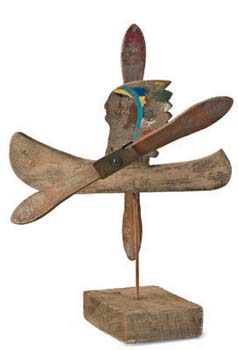Whirligig of Native American Indian in Canoe
- Early 20th century
- Artist unknown
- Wood and paint
49.1 x 40.0 16.5 cm., 19-3/16 x 15-3/4 x 6-1/2"
- Catherine Carter Goebel, Paul A. Anderson Chair in the Arts Collection Purchase, Paul A. Anderson Art History Collection, Augustana College 2001.39

Essay by Veronica Smith, Class of 2012
Growing up in a relatively rural area, the pivotal event of the year was always the town fair. Vendors from all over the country would make the pilgrimage to our small town, hauling thousands of pounds of steel that would magically unfold into rides and food stands. Colorful tents would spring into shape overnight, only to be populated in the morning by every imaginable craft item-custom carved wooden toilet seats with matching carved Kleenex boxes, air-brushed t-shirts, candles formed in the shape of every breed of dog imaginable, and of course, whirligigs.
Unable to be confined to a tent, these whimsical creations whirled close to the walkways, inviting fair-goers to indulge their child-like wonder. Miniature kinetic sculptures, these usually hand-crafted pieces react to every whim of the wind. Despite their kitschy connotation in contemporary culture, whirligigs have appeared for centuries in many works of art. Though few if any whirligigs survive from the time of Hieronymus Bosch, a Dutch painter during the Early Netherlandish Renaissance, this artist depicted many whirligigs (Gibson 9-15).
Said to have originated as miniature versions of the windmills that punctuate the Dutch landscape, whirligigs survived as an art form through the time of Bosch into the 19th century. As evidenced by a letter written by Caroline Elizabeth Wilde Cushing (daughter of Massachusetts Justice Samuel S. Wilde) in 1829, where she comments on the whirligigs she had seen in Bordeaux, France (Wilde 256-269). Had Ms. Cushing traveled the countryside in her native land, she might have encountered some whirligigs there as well, as the tradition was brought to America from Europe.
This particular whirligig depicts a generic Native American, replete with brightly painted headdress and paddles, seated in a canoe. Probably whittled, this whirligig was most likely made by hand for a private residence sometime in the early 20th century, and enjoyed a long life exposed to the elements, judging by the wear on the paint job. So persistent is this art form that it still enjoys a certain folk popularity, attested to by the prominent presence of whirligigs for sale at my hometown's annual fair.
